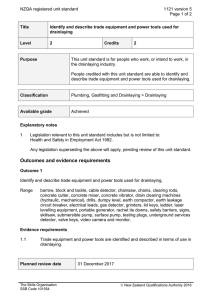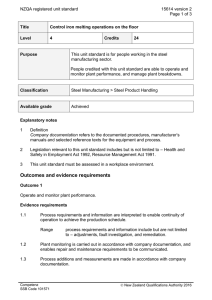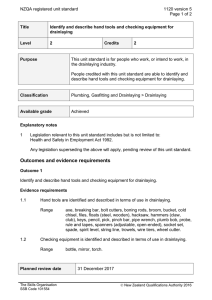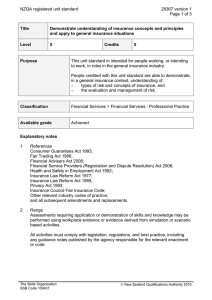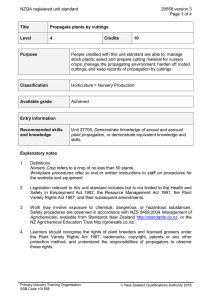NZQA registered unit standard 27708 version 1 Page 1 of 4
advertisement
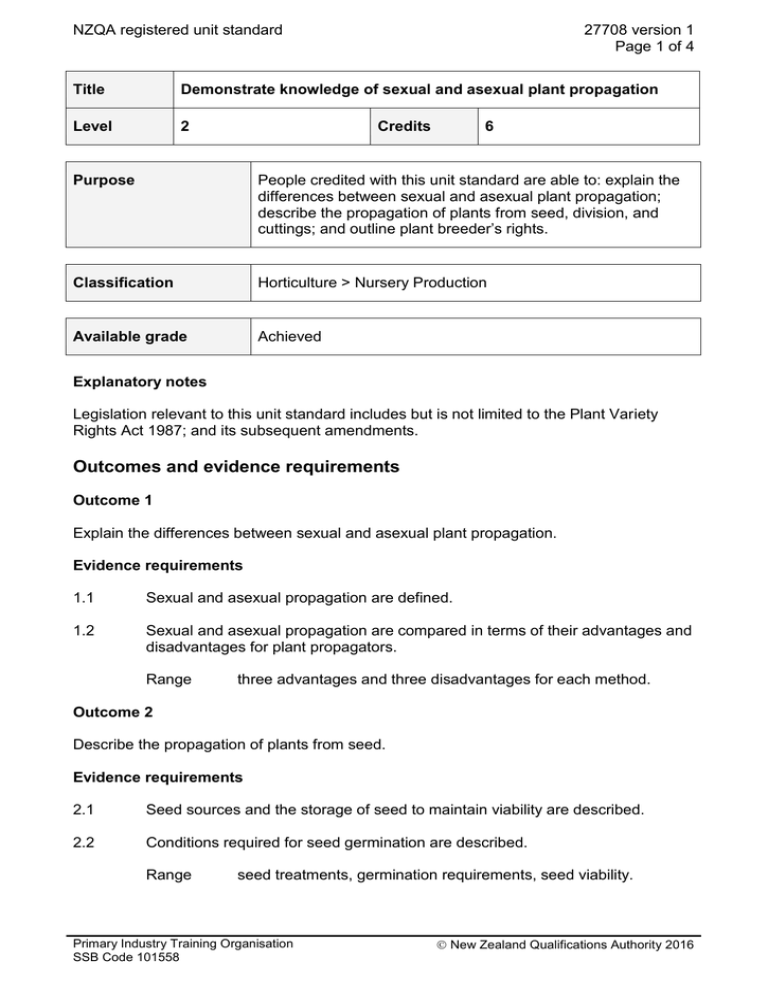
NZQA registered unit standard 27708 version 1 Page 1 of 4 Title Demonstrate knowledge of sexual and asexual plant propagation Level 2 Credits 6 Purpose People credited with this unit standard are able to: explain the differences between sexual and asexual plant propagation; describe the propagation of plants from seed, division, and cuttings; and outline plant breeder’s rights. Classification Horticulture > Nursery Production Available grade Achieved Explanatory notes Legislation relevant to this unit standard includes but is not limited to the Plant Variety Rights Act 1987; and its subsequent amendments. Outcomes and evidence requirements Outcome 1 Explain the differences between sexual and asexual plant propagation. Evidence requirements 1.1 Sexual and asexual propagation are defined. 1.2 Sexual and asexual propagation are compared in terms of their advantages and disadvantages for plant propagators. Range three advantages and three disadvantages for each method. Outcome 2 Describe the propagation of plants from seed. Evidence requirements 2.1 Seed sources and the storage of seed to maintain viability are described. 2.2 Conditions required for seed germination are described. Range seed treatments, germination requirements, seed viability. Primary Industry Training Organisation SSB Code 101558 New Zealand Qualifications Authority 2016 NZQA registered unit standard 27708 version 1 Page 2 of 4 2.3 Seed raising media, containers for seed raising, and soil conditions for fieldsown seed are described. 2.4 Seed sowing in containers and in the field are described. Range two methods for each. 2.5 The maintenance of conditions for seed germination and seedling establishment in containers and in the field is described. 2.6 Two reasons for growing plants from seed are stated. Outcome 3 Describe the propagation of plants from division. Evidence requirements 3.1 Common types of divisions are described, and two examples of plants grown by each method are listed. Range crowns, rhizomes, tubers, bulbs, corms, runners. 3.2 Division timing and the selection of suitable parent plant material are described in general terms. 3.3 The establishment and after care of divided plant material are described. 3.4 Two reasons for growing plants from division are stated. Outcome 4 Describe the propagation of plants by cuttings. Evidence requirements 4.1 Common types of cuttings are described, with two examples of plants propagated by each method. Range stem cuttings (hardwood cuttings, semi-hardwood cuttings, soft wood cuttings, leaf cuttings, root cuttings), evergreen and deciduous. 4.2 The selection of suitable cutting material is described in terms of plant type and timing. 4.3 The selection of suitable propagation media and containers, and suitable soils for setting cuttings in the field, are described. 4.4 Suitable environments for cutting propagation are described. Range greenhouse or protected environments, in the field. Primary Industry Training Organisation SSB Code 101558 New Zealand Qualifications Authority 2016 NZQA registered unit standard 27708 version 1 Page 3 of 4 4.5 The care of cuttings until rooted is described. 4.6 Two reasons for propagating plants from cuttings are stated. Outcome 5 Outline plant breeder’s rights. Evidence requirements 5.1 The forms of protection available and the rights of plant breeders and licensed growers are outlined in general terms. Range may include - Plant Variety Rights, trademarks, copyright, patents. Replacement information This unit standard and unit standard 27707 replaced unit standard 20556. Planned review date 31 December 2017 Status information and last date for assessment for superseded versions Process Version Date Last Date for Assessment Registration 1 19 April 2012 N/A Consent and Moderation Requirements (CMR) reference 0032 This CMR can be accessed at http://www.nzqa.govt.nz/framework/search/index.do. Please note Providers must be granted consent to assess against standards (accredited) by NZQA, before they can report credits from assessment against unit standards or deliver courses of study leading to that assessment. Industry Training Organisations must be granted consent to assess against standards by NZQA before they can register credits from assessment against unit standards. Providers and Industry Training Organisations, which have been granted consent and which are assessing against unit standards must engage with the moderation system that applies to those standards. Requirements for consent to assess and an outline of the moderation system that applies to this standard are outlined in the Consent and Moderation Requirements (CMR). The CMR also includes useful information about special requirements for organisations wishing to develop education and training programmes, such as minimum qualifications for tutors and assessors, and special resource requirements. Primary Industry Training Organisation SSB Code 101558 New Zealand Qualifications Authority 2016 NZQA registered unit standard 27708 version 1 Page 4 of 4 Comments on this unit standard Please contact the Primary Industry Training Organisation standards@primaryito.ac.nz if you wish to suggest changes to the content of this unit standard. Primary Industry Training Organisation SSB Code 101558 New Zealand Qualifications Authority 2016

